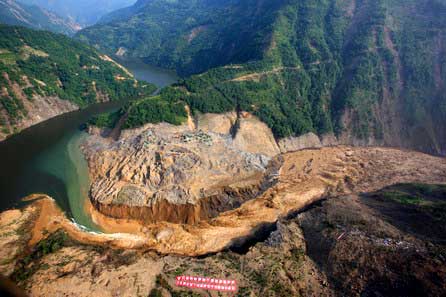Boating on Quake Lake Coming Soon
Adjust font size:
|
|
|
Picture taken on June 10, 2008 from a military helicopter shows the drainage of the Tangjiashan quake lake in southewest China's Sichuan Province. [Xinhua] |
Some of the ruins created by the quake last year in Beichuan County, Sichuan Province, will open to visitors later this month, an official said on Tuesday.
Chen Wen, an information officer in the city of Mianyang, which controls Beichuan, said tourist groups will be able to visit the ruins of the high schools that were the site of both massive tragedy and huge bravery.
During this year's Spring Festival, some 200,000 people visited the county, he said.
In response to the demand, authorities in Mianyang decided to launch a tour program to take people to see the tragic sites, Chen said.
The one-day tour includes a visit to Beichuan High School and Jina Qiang village, he said.
Eighty percent of the buildings in Beichuan were leveled in the quake, Chen said.
The new tour will allow people to see the devastation from a vantage point on a nearby hillside, he said.
Jina Qiang village is home to people from the Qiang ethnic minority group and was the first to be rebuilt after the earthquake.
About 10 percent of the 300,000 people who lived in Beichuan -- the country's only autonomous Qiang county -- died in the quake.
Qiang people traditionally live in stone towers, 69 of which have been rebuilt so far.
The Mianyang government will spend 900 million yuan (US$131 million) to turn earthquake ruins in Beichuan, Anxian and Pingwu and Jiangyou into top tourism sites, the Sichuan provincial tourism administration said.
Despite the area being a site of enormous tragedy, visitors will be able to go boating on the Tangjiashan "quake lake" and sit on its shores drinking tea and relaxing. Meanwhile their friends can enjoy an "earthquake simulation" at a local museum, a tourism official said.
In related news, the May 12 Wenchuan Earthquake Museum will open in Dayi, Sichuan, on May 12.
Fan Jianchuan, curator of the museum, said the new site will include a giant porcelain plate featuring images of everyone who died in the earthquake.
He Xinyong, deputy curator, said the new museum will also provide a home to Zhu Jianqiang (Strong Pig), the hog that survived more than a month under a collapsed building after the quake.
(China Daily March 4, 2009)
